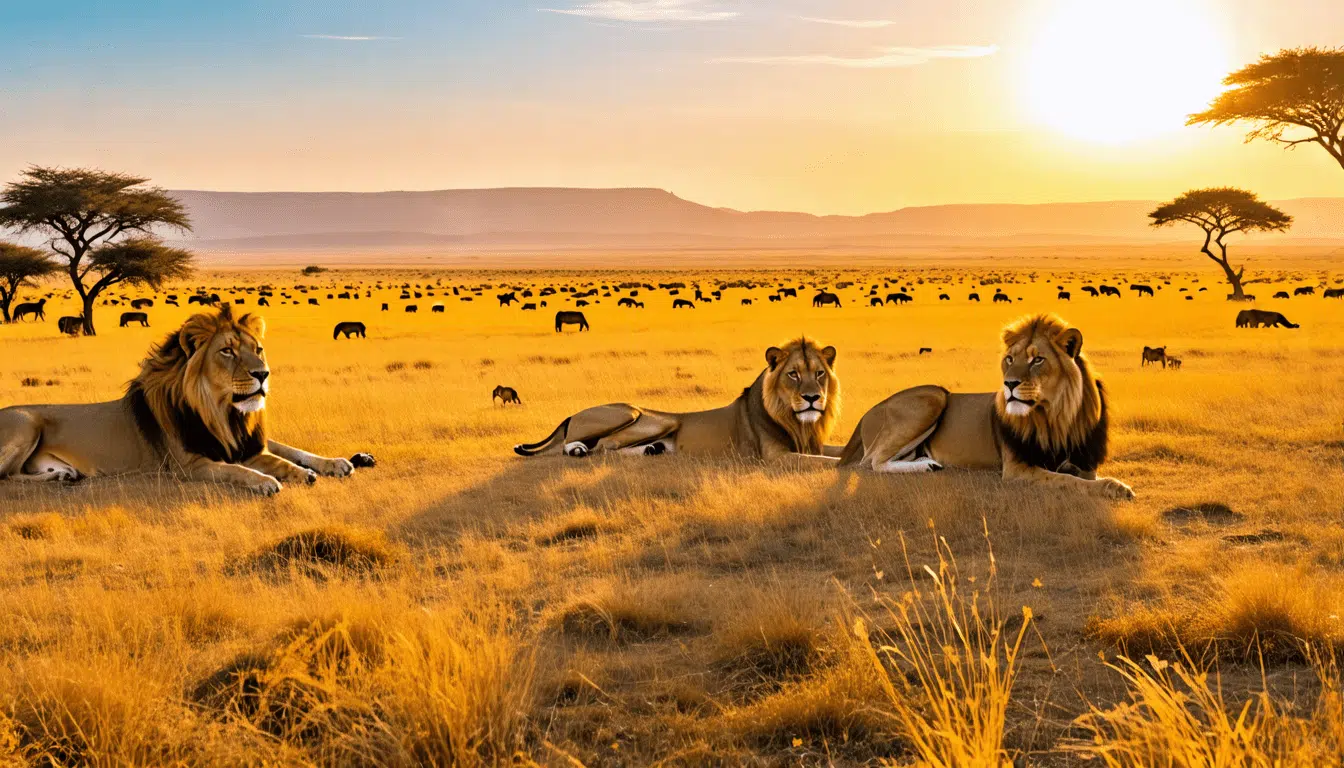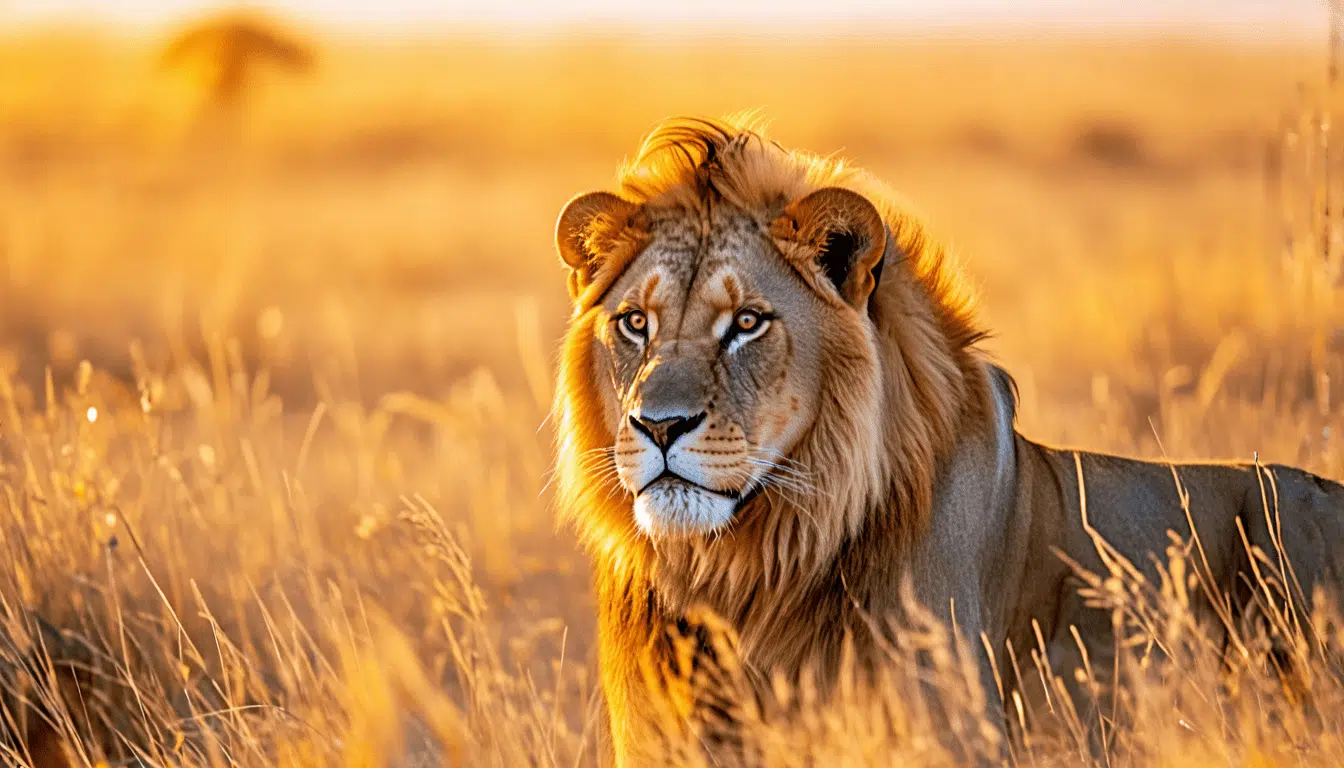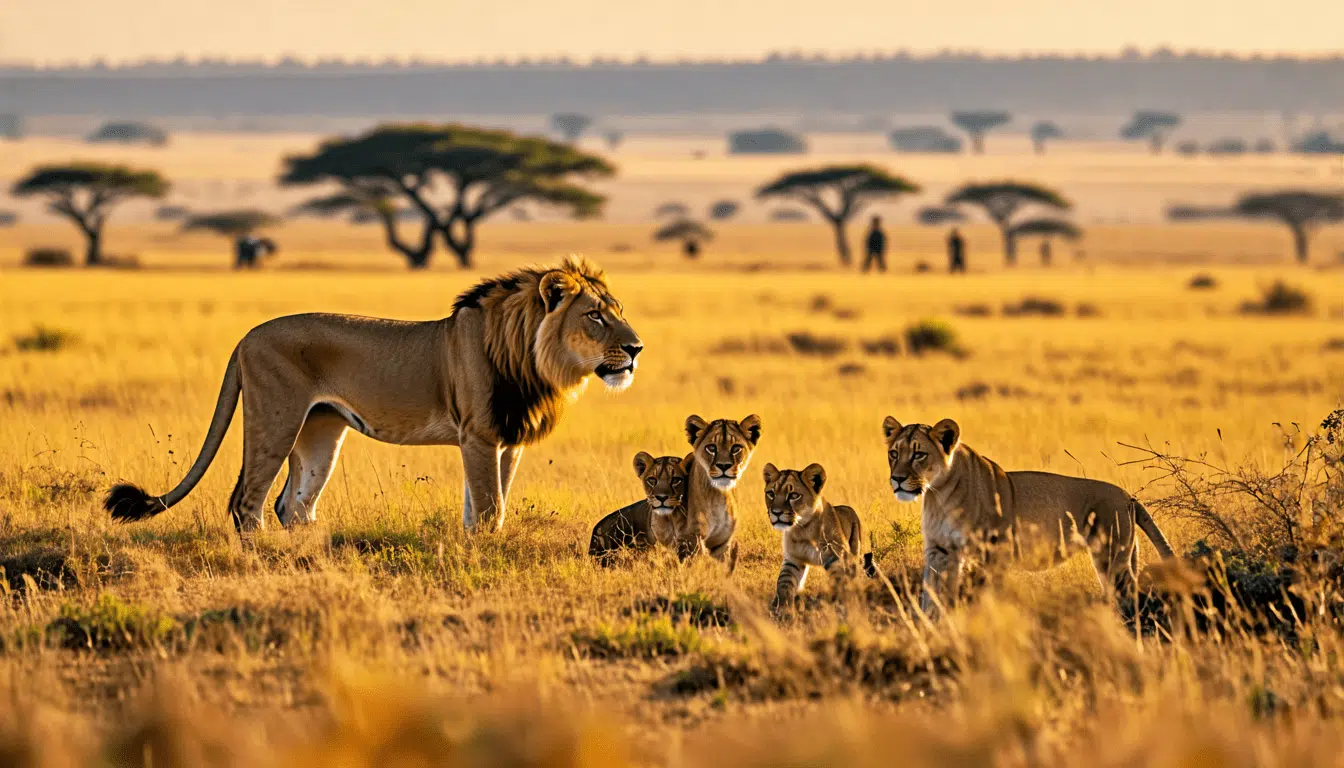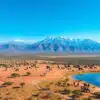Introduction to Lion Tourism in East Africa
Imagine standing in the vast savannas of East Africa, the golden grasses stretching endlessly, interrupted only by the occasional acacia tree. Suddenly, you spot a majestic lion, its mane catching the morning light just perfectly. Isn’t that a sight we all long to witness? East Africa isn’t just the stuff of safari dreams—it’s the real deal for those who want to see lions in their natural habitat. But what makes this part of the world such a top-notch destination for lion tourism? Glad you asked.
For starters, lions aren’t just big celebrities on the plains; they’re an integral part of East Africa’s rich biodiversity. These magnificent creatures play a critical role in maintaining the balance of the ecosystem by keeping herbivore populations in check. Plus, let’s face it—they’re a massive draw for tourism. Visitors flock from around the globe just to catch a glimpse of these regal animals in the wild, making them a significant contributor to the local economy. And who wouldn’t want to support the community and conservation efforts while ticking an item off their bucket list?
Geographically speaking, East Africa serves up the perfect mix of diverse habitats, from sweeping grasslands to lush river ecosystems, all tailored to support thriving lion populations. The Serengeti plains, the Maasai Mara, the savannas of Uganda—these are no ordinary tourist stops. They are lion country, with each location offering a unique vantage point to observe these incredible animals in action.
So pack your binoculars and sense of adventure, folks. East Africa’s lion landscapes are calling, and it’s an invitation you won’t want to miss.
Introduction to Lion Tourism in East Africa
Why East Africa is a Prime Destination for Observing Lions
Picture this: you’re in the heart of the African savannah, the sun just beginning to rise, casting a golden hue over the endless plains. You feel that undeniable thrill of anticipation just waiting to catch a glimpse of the magnificent lion—nature’s undeniable royalty. Why is East Africa the ultimate destination for such an experience? It’s simple: the region is like no other, offering an unparalleled opportunity to witness lions in all their majestic glory, in their natural habitats.
Let’s face it, lions have always captivated our imaginations. From storybooks to Hollywood, they are the ultimate symbol of power and majesty. And in East Africa, they’re not just a subject of fairytales; they are a real and vibrant part of the ecosystem. The Serengeti’s endless plains and the lush expanses of the Masai Mara make East Africa a prime destination because these areas provide the perfect stage for viewing lions in their natural performances of life and survival.
The Significance of Lions to the Region’s Biodiversity and Economy
Lions play a key role in maintaining the balance of East Africa’s biodiversity. They are apex predators, meaning they help control the population of herbivores, which in turn affects vegetation dynamics and overall ecosystem health. Have you ever wondered why this is so crucial? Without lions, there could be an overpopulation of grazing animals, birthing an imbalance that ripples throughout the food chain.
But it isn’t just about the balance of nature. Lions are also a vital part of East Africa’s economy, thanks to tourism. People flock from all corners of the globe to witness these majestic creatures firsthand. Their awesomeness draws in tourists, bringing income that supports local communities and fosters conservation efforts. Here’s a personal tidbit: on my first safari, the palpable excitement within our tour group as we spotted our first lion was as if we were all kids on Christmas morning, and in that moment, we all became part of a larger economic ecosystem.
Geography and Habitats Supporting Lion Populations
Have you ever thought about what makes a particular place suitable for lions? In East Africa, it’s all about the geography and habitats. The region is blessed with vast savannahs, open woodlands, and a remarkable climate that create perfect conditions for lions to thrive. Areas like the Serengeti and Masai Mara are not just pretty faces; they are ecologically rich environments with diverse prey populations, ample space for pride territories, and resources for survival.
The landscape in East Africa varies significantly, from the grass-covered plains of the Serengeti to the acacia-dotted savannahs of the Masai Mara. These diverse habitats allow different lion prides to adapt and evolve, shaping their behaviors and social structures. Have you ever watched a documentary and seen a lion pride lounging under the shade of an acacia tree? That’s typical behavior made possible by East Africa’s unique environment. Who knows, maybe your own safari will narrate a scene just like that!
In summary, East Africa isn’t just a destination; it’s an experience—a living, breathing stage where lions roam freely in a world that is as real as it is wild. It’s the home of the kings and queens of the animal kingdom, and for those who venture there, it promises a glimpse into a beautifully intricate world that we are privileged to witness.
Top National Parks for Lion Watching
When you think of lions lounging under the African sun, East Africa’s breathtaking national parks likely come to mind. If you’re anything like me, you’ve probably dreamed about seeing the iconic lion prides of the Serengeti or the captivating tree-climbing lions of Uganda. This section explores some of the best places to turn that dream into reality, giving you an inside scoop on where to catch these majestic creatures in their natural habitat.
Serengeti National Park, Tanzania
The Serengeti. Just saying the name conjures up images of vast open plains and endless skies. It’s like the land was made for lion watching. Located in northern Tanzania, the Serengeti National Park is one of the most renowned ecosystems on the planet, and for good reason! With its diverse range of habitats, from grasslands to woodlands, it provides the perfect backdrop for some of the most awe-inspiring lion sightings. Did you know the park is home to over 3,000 lions? It hosts several famous lion prides, such as the Simba Kopjes pride, which has been featured in numerous documentaries and research studies.
I’ve heard stories of visitors leaping out of bed at dawn, fueled by the joy of possibly witnessing a lioness on the prowl or a pride resting after a nocturnal hunt. And the best part? The Great Migration also passes through the Serengeti, meaning you don’t just see lions—you see nature’s greatest show. It’s like hitting the wildlife jackpot!
Masai Mara National Reserve, Kenya
Next up, just across Tanzania’s border, lies the enchanting Masai Mara National Reserve in Kenya. This park is where you’ll witness dramatic scenes straight out of a wildlife documentary, with lions playing a starring role. The Mara’s beauty is legendary, but its real claim to fame is the annual wildebeest migration between July and October. During this time, lions are particularly active, drawn by the abundance of prey. It’s a feast for the eyes—and for the lions!
Imagine sitting in an open-roof Land Rover, camera in hand, watching a lion pride expertly coordinate to take down their next meal. It’s an adrenaline rush that no video game could ever replicate. The richness of the Mara’s wildlife can’t be overstated, and with a bit of luck and patience, you could find yourself face-to-face with a lion stalking through the savanna.
Queen Elizabeth National Park, Uganda
Uganda’s Queen Elizabeth National Park might not immediately spring to mind when you think of lions, but it boasts a unique twist that sets it apart: tree-climbing lions. Yes, you read that right. These lions have defied expectations by chilling out in the branches of trees, offering a unique lion-watching experience you won’t find everywhere else in Africa.
During my visit, I remember craning my neck skyward, almost convinced I was looking for a bird rather than a big cat. But there they were, draped casually over branches, as if posing for a postcard photo. Not only is it a great place to spot these agile cats, but the park also offers stunning views of the Kazinga Channel, not to mention the chance to see hippos, elephants, and more, making it the safari version of a meat-lover’s pizza—something for everyone.
Ruaha National Park, Tanzania
Last but certainly not least, there’s the often-overlooked Ruaha National Park. Nestled deep in Tanzania’s heart, Ruaha is like an uncut gem waiting to be discovered. With a lion population rumored to exceed 10% of the world’s total, it really boggles the mind how this place isn’t more crowded. But that’s the beauty of it—quiet, secluded, and oh-so-alluring.
Ruaha’s varied landscape includes rivers, woodlands, and savannas, providing a dramatic backdrop for unforgettable lion encounters. Watching a pride of lions lazing by the Great Ruaha River is a sight to behold, and because the park isn’t swarming with tourists, your experience is intimate and personal. It’s an ideal spot for the discerning traveler who prefers the road less traveled, and who knows? You might just get the honor of being the lions’ sole audience for a day.
So, whether you choose the plains of the Serengeti or the secluded corners of Ruaha, East Africa’s parks offer a slice of the wild that’s nothing short of mesmerizing. Just remember to pack your camera and a sense of adventure—you’ll need both!
Best Times and Tips for Lion Spotting
Ideal Seasons for Lion Spotting
You’ve probably heard the myth that lions are always out and about, their golden manes shimmering in the sun, waiting for their next photoshoot. But surprise, surprise—they’re not always as cooperative as we’d like. Timing is everything. In East Africa, the best time for lion spotting largely depends on where you’re headed.
If you’re planning a visit to the Serengeti National Park in Tanzania, your best bet is during the dry season, from June to September. Why? Well, the grass is low, and the wildlife gathers around waterholes making their movements predictable. The Masai Mara in Kenya is stunning during the Great Migration (July to October) but can be crowded; however, it’s a sight worth every safari truck encounter.
For those venturing to Queen Elizabeth National Park in Uganda, try the drier months of January and February or June to September. The famous tree-climbing lions are best spotted during these periods when their lazing is at its peak. And then there’s Ruaha National Park in Tanzania, which might not be as well-trodden, but visiting from June to October ensures you won’t miss the lions lurking around the park’s sprawling territory.
Practical Tips for Tourists
Now, let’s talk tactics. Even the most seasoned safari-goers agree that having a stellar guide is key. A great guide not only knows where the lions are but also has a sense of humor to keep you entertained during those waiting periods. Do your research and book with local operators like "Explore Tanzania" or "Wildlife Safaris Kenya", which often employ locals who grew up tracking wildlife before they could walk.
Alternatively, consider joining a guided tour that offers experiential learning as you spot lions. Imagine sipping tea while listening to a Maasai guide recount folklore about the king of the savannah. Meanwhile, take notes—these stories are priceless and the envy fodder of your Instagram followers.
What to Bring and How to Respect Wildlife Rules
So, you’ve locked in your travel dates and booked your safari. What’s next? Let’s pack your bags with the essentials. A pair of binoculars is a non-negotiable item. Ask yourself, do you want to be that person asking to borrow someone else’s binoculars just as the lion pack decides to sprint across the veldt?
Speaking of watching lions, remember to carry a decent camera. You don’t have to turn into a Nat Geo filmmaker overnight, but a camera with a good zoom lens will capture the majestic feline far better than your smartphone. Trust me.
Now, let’s chat about respecting the wildlife. Have you ever been irritated by tourists walking into quiet museum exhibitions only to chat loudly and disrupt the experience? It’s no different in the animal kingdom. Silence and patience are your best allies on safari. Lions have keen senses, and each roar or snap of a twig can change their course.
Moreover, always follow your guide’s instructions. Lions may look as calm as a cat by the fire, but remember, they’re wild animals, and your safety depends on respecting their space. Finally, never leave the vehicle unless your guide explicitly says it’s safe. Safety first, folks!
In summary, spotting lions in East Africa can be the adventure of a lifetime but requires a bit of planning and a sprinkle of wisdom. Pack wisely, listen closely, and prepare for a landscape as vibrant as the lions themselves. Safari Njema—or as you’d say in English—have a good journey!
Conservation Efforts and Lion Protection
Ever thought about how that heart-stopping moment of spotting a lion in the wild is possible? I mean, it’s not just luck or a well-timed safari truck, right? Behind every lion sighting in East Africa lies a world of dedicated individuals and groundbreaking initiatives working tirelessly to ensure that these majestic creatures continue to roam freely where they belong.
Ongoing Conservation Initiatives
Let’s dive into the heart of the matter. East Africa has become a focal point for lion conservation, spearheaded by passionate organizations and communities. One of the key players in this arena is the African Wildlife Foundation (AWF). Their work revolves around safeguarding habitats and supporting local communities. Picture this: They help construct corridors linking fragmented habitats, so lions and other wildlife can roam more freely. It’s sort of like giving a green light to a wildlife highway, allowing lions to move without unnecessary roadblocks.
Then there’s the Lion Guardians program in Kenya and Tanzania. They’re transforming Maasai warriors—whose traditional rite of passage was hunting lions—into passionate protectors of these big cats. I’ve met a few of these guardians during my travels, and let me tell you, their commitment is nothing short of inspiring. They track lion movements, mediate human-wildlife conflicts, and importantly, raise awareness in their communities about the value of lions.
Tourism: A Pillar of Support
Now, how does tourism fit into this picture, you might wonder? It’s more vital than you think. Last time I visited the Serengeti, the guide mentioned that a portion of the park fees goes directly to conservation projects. So every time you grab your binoculars and capture a lion on camera, you’re contributing to the conservation funding. Isn’t that a fantastic feeling? Tourism provides crucial financial support, channeling funds into protective measures, research, and community education programs.
But let’s get down to brass tacks. It’s not just about money. Tourism has a massive ripple effect on local economies. It creates jobs, boosts incomes, and invests back into communities—thereby reducing the reliance on hunting or land use that could harm lion populations.
Encouraging Responsible Tourism
Alright, here’s where you come in. Yes, you. As tourists, we wield considerable power in the conservation conversation. The choices you make can significantly impact lion protection efforts. Wondering how you can be a responsible traveler? It starts even before you pack your bags. Consider opting for eco-friendly tour operators who are committed to wildlife conservation and community development.
Once on safari, simple actions can make a huge difference. Respecting wildlife rules by keeping your distance and understanding that observing is more valuable than invading a lion’s space. I once watched in admiration as a seasoned guide calmly explained to a group of tourists why staying quiet in the presence of a lion was crucial. His patience reminded me that education often travels hand in hand with experience.
And let’s not forget post-trip actions. Share your experiences and insights gained from your travels. Use social media to raise awareness about the importance of conservation and responsible tourism. It’s like planting seeds that can grow into collective action. Believe me, each story shared contributes to a broader understanding of why these magnificent creatures need our protection.
Contribute from Home
Finally, what if you’re not planning a trip just yet? Can you still help conserve lions? Absolutely. Organizations like the African Wildlife Foundation rely on donations to continue their critical work. Supporting their efforts can have a direct impact on conservation programs. You can even adopt a lion through certain programs, providing needed funds for their protection while receiving updates and stories about your adopted animal.
You see, every little action counts. So, whether you’re wandering the African savannas or reading from your living room, you’re part of this story—contributing to a future where lions continue to reign over East Africa’s landscapes. Isn’t it incredible to think our collective efforts could shape the legacy of these kings of the wild?
Conclusion
Reflecting on the grandeur of East Africa and its majestic lions, it’s clear that this region offers an unparalleled experience for those eager to witness the King of the Jungle in its natural habitat. The landscapes of the Serengeti, the Masai Mara, Queen Elizabeth, and Ruaha are more than just backdrops; they are vibrant ecosystems teeming with life, each with its own unique symphony of wildlife that includes the awe-inspiring lion.
Throughout my travels, I’ve found there’s nothing quite like the anticipation of a safari at dawn, the crisp air alive with promise, as you scan the horizon for a glimpse of a tawny mane amidst the grasses. Can you feel the excitement too? It’s this shared adrenaline rush that links us to the rich tapestry of nature and our collective responsibility to protect it.
And protect it we must. Did you know that by embarking on these adventures, we also become guardians of sorts? Tourism is not just about ticking off the Big Five from your list—though there’s a thrill in that, of course. It’s about contributing to conservation efforts that battle the challenges lions face today, from habitat loss to human conflict. And these efforts, largely funded by tourism, ensure that future generations will witness the same spectacular landscapes and wildlife wonders.
The next time you embark on a lion-watching pilgrimage, remember that your journey is part of something larger. Whether it’s choosing eco-friendly tour operators or investing time to learn how your visit supports local communities, your actions are impactful. So pack responsibly, travel respectfully, and show the same respect and admiration for the lions as those who have dedicated their lives to their preservation.
Visiting these magnificent animals in East Africa is not just about what’s at the end of your camera lens; it’s about creating a symbiotic relationship with the natural world. So, are you ready to contribute to this legacy, and perhaps, inspire others to do the same? The lions are waiting.






